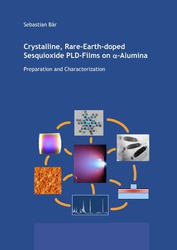| Areas | |
|---|---|
| Serie de libros (96) |
1378
|
| Nachhaltigkeit |
3
|
| Gesundheitswesen |
1
|
| Letra |
2363
|
| Ciencias Naturales |
5406
|
| Matemática | 229 |
| Informática | 319 |
| Física | 980 |
| Química | 1363 |
| Geociencias | 131 |
| Medicina humana | 243 |
| Estomatología | 10 |
| Veterinaria | 108 |
| Farmacia | 147 |
| Biología | 835 |
| Bioquímica, biología molecular, tecnología genética | 121 |
| Biofísica | 25 |
| Nutrición | 45 |
| Agricultura | 1004 |
| Silvicultura | 201 |
| Horticultura | 20 |
| Ecología y conservación de la tierra | 148 |
| Ciencias Ingeniería |
1791
|
| General |
98
|
|
Leitlinien Unfallchirurgie
5. Auflage bestellen |
|
Erweiterte Suche
Crystalline Rare-Earth-doped Sesquioxide PLD-Films on alpha-Aluminia (Tienda española)
Sebastian Bär (Autor)Previo
Indice, Datei (35 KB)
Indice, Datei (33 KB)
Lectura de prueba, Datei (130 KB)
Lectura de prueba, Datei (280 KB)
The development of integrated optical devices demands the fabrication of high-quality optically active thin films. This work focuses on thin sesquioxide films, which are promising because the sesquioxides are well-known hosts for rare-earth-ions, leading to luminescent materials and solid-state lasers with superior mechanical and thermal properties (e. g. low phonon energies, large thermal conductivity).Optical quality crystalline thin films of rare-earth-doped sesquioxides (yttria, lutetia, and scandia) have been grown by the pulsed laser deposition (PLD) technique on single-crystal (0001) a-alumina substrates. Alumina substrates offer a lattice constant that matches that of cubic Y2O3 in the á111ñ direction very well. Using Lu2O3 and Sc2O3, the mismatch of 4.8% related to Y2O3 on alumina substrates can be considerably reduced leading to the production of films with less dislocations.The crystal structure of these films (thicknesses from 1 nm to 500 nm) was determined by X-ray diffraction (XRD) and surface X-ray diffraction (SXRD) analysis. These measurements show that the films were textured along the á111ñ direction, however with a small polycrystalline component, which is negligible in thick films. Using Rutherford backscattering analysis (RBS), the correct stoichiometric composition of the films could be proved. At optimum growth conditions, epitaxial growth of Y2O3 along the á111ñ direction on the 0001 a-Al2O3 was experimentally verified by the observation of channelling in the RBS experiments.The surface morphology of the thin films has been studied using atomic force microscopy (AFM). While amorphous films have no defined surface structure, crystalline films show a triangular surface morphology, which is attributed to the á111ñ growth direction. The same structure is observed along the {111} cleavage of an yttria bulk crystal. Thin films with a mean thickness of 5 nm have no completely covered surface, but show island growth, where the shape of the single crystallites, having angles of 60° or 120° , indicates the á111ñ growth direction during the early stages of film growth.To study the optical properties of the rare-earth-doped films, spectroscopic measurements in the (vacuum-) ultraviolet and visible spectral-range have been carried out. The emission and excitation spectra of the Eu3+-doped films look similar to those of the corresponding crystalline bulk material down to a film thickness of 100 nm, i. e. the symmetry around the Eu3+-ions is preserved, whereas films with a thickness £ 20nm show a completely different emission behavior. This change can be explained by subplantation effects of high-energy plasma species hitting the substrate surface, leading to mixed compounds like Y3Al5O12. In addition, surface effects due to a large surface-to-volume ratio of the observed islands have a significant impact on the ‘film’ properties.For possible applications in integrated optics, waveguide experiments have been performed in the system Y2O3–Al2O3. Single-mode guiding of the fundamental mode was demonstrated in the 1 µm thick yttria layer.
| ISBN-10 (Impresion) | 3865371493 |
| ISBN-13 (Impresion) | 9783865371492 |
| ISBN-13 (E-Book) | 9783736911499 |
| Idioma | Alemán |
| Numero de paginas | 152 |
| Edicion | 1 Aufl. |
| Volumen | 0 |
| Lugar de publicacion | Göttingen |
| Lugar de la disertacion | Göttingen |
| Fecha de publicacion | 28.07.2004 |
| Clasificacion simple | Tesis doctoral |
| Area |
Física
|








